What is Data Flow Analysis
- Local analysis (e.g., value numbering)
- analyze effect of each instruction
- compose effects of instructions to derive information from beginning of basic block to each instruction
- Data flow analysis
- analyze effect of each basic block
- compose effects of basic blocks to derive information at basic block boundaries
- from basic block boundaries, apply local technique to generate information on instructions
- Flow-sensitive: sensitive to the control flow in a function
- intra-procedural analysis
- Examples of optimizations:
- Constant propagation
- Common subexpression elimination
- Dead code elimination
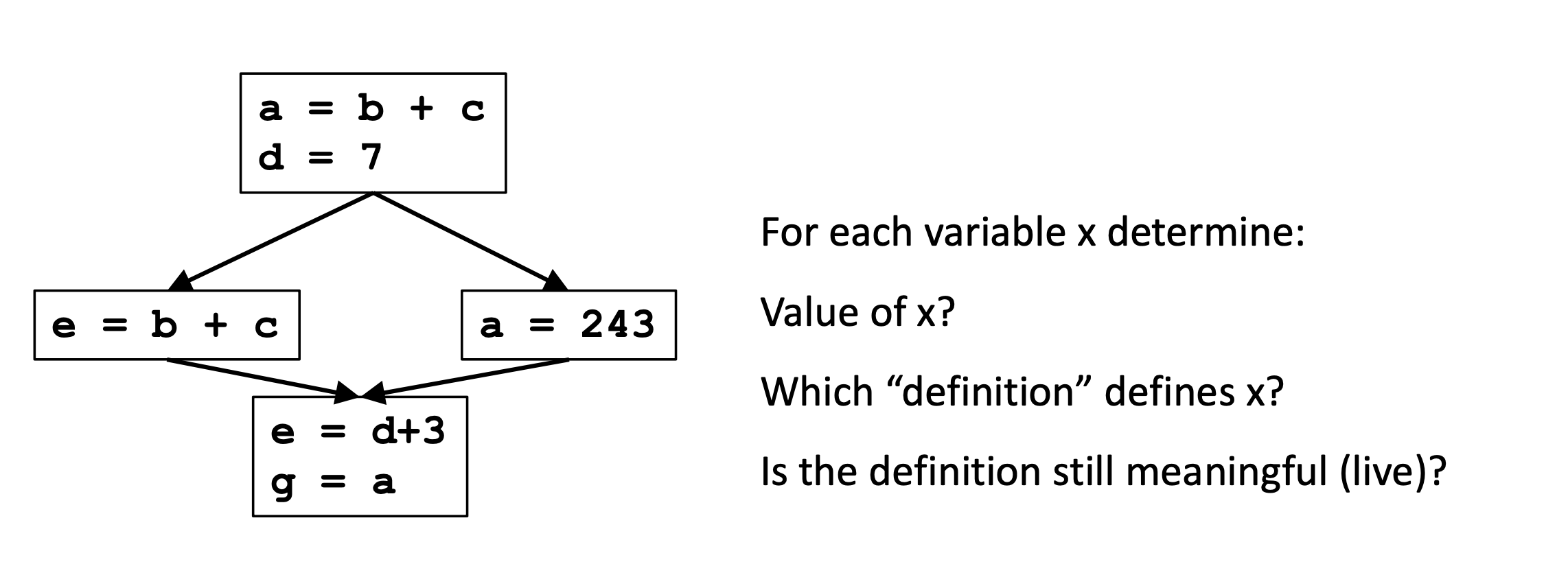
- Static Program vs. Dynamic Execution
- Statically: Finite program
- Dynamically: Can have infinitely many possible execution paths
- Data flow analysis abstraction:
- for each point in the program: combines information of all the instances of the same program point
- Example of a data flow question:
- Which definition defines the value used in statement “b=a”
Reaching Definition
- Effect of a statement:
a = b + c- Uses variables (b,c)
- Kills an old definition (old definition of a)
- new definition (a)
- Compose effects of statements -> Effect of a basic block
-
A locally exposed use in a b.b is a use of a data item which is not preceded in the b.b by a definition of the data item
-
Any definition of a data item in the b.b kills all definitions of the same data item reaching the basic block.
-
A locally available definition = last definition of data item in b.b
-
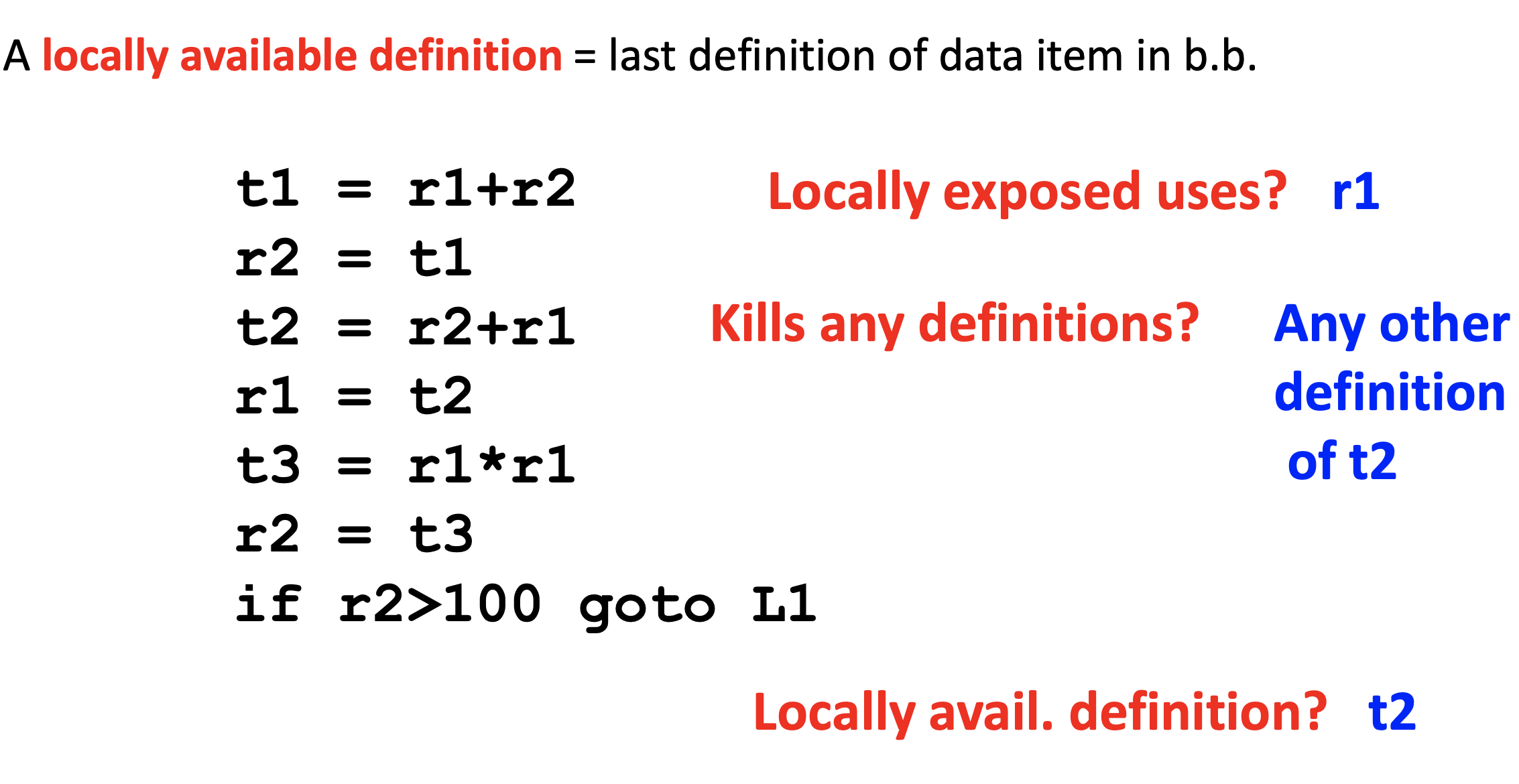
-
Every assignment is a definition
-
A definition d reaches a point p if there exists path from the point immediately following d to p such that d is not killed (overwritten) along that path.
Problem Setup
- Problem statement
- For each point in the program, determine if each definition in the program reaches the point
- A bit vector per program point, vector-length = #defs
- Build a flow graph(nodes = basic blocks, edges = control flow)

- Set up a set of equations between in and out for all basic block
- Effect of code in the basic block:
- Transfer function $f_b$ relates in[$b$] and out[$b$] for same b
- Effect of flow of control:
- relates out[$b_1$], in[$b_2$] if $b_1$ and $b_2$ are adjacent
-
Find a solution to the equations
- $f_s$: A transfer function of a statement
- Abstracts the execution with respect to the problem of interest
- For a statement s
(d: x = y + z)- $outs[s]$ = $f_s(in[s])$ = Gen[s] $\cup$ (IN[s] - Kill[s])
- Gens[s]: definitions generated: Gen[s] = d
- Propagated definitions: $in[s] - kill[s]$
- Where Kill[s] = set of all other definitions to x in the rest of program
- Transfer function of a statement s:
- out[s] = $f_s(in[s])$ = $Gen[s] \cup (In[s] - Kill[s])$
- Transfer function of a basic block B
- Composition of transfer functions of statements in B
- Eg: $f_b$ = $f_{d2} \cdot f_{d1} \cdot f_{d0}$
- out[B] = $f_B(in[B])$ = $f_{d_2} \cdot f_{d_1} \cdot f_{d_0} (in[B])$
- $Gen[d_2] \cup (IN[d_2] - KILL[d_2])$
- $Gen[d_2] \cup ((Out[d_1]) - KILL[d_2])$
- $Gen[d_2] \cup ((Gen[d_1] \cup (In[d_1] - Kill[d_1])) - Kill[d_2])$
- $Gen[d_2] \cup ((Gen[d_1] \cup (Out[d_0] - Kill[d_1])) - Kill[d_2])$
- $Gen[d_2] \cup ((Gen[d_1] \cup ((Gen[d_0] \cup (In[d_0] - Kill[d_0])) - Kill[d_1])) - Kill[d_2])$
- Gen[$B$] $\cup$ (in[$B$] - Kill[$B$])
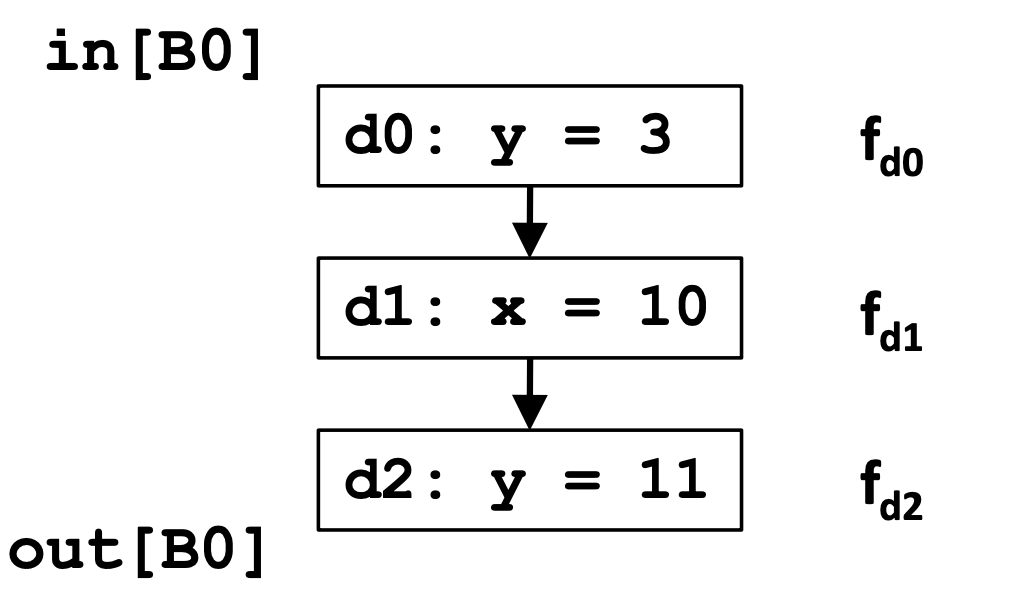
- Effect of code in the basic block:
Effects of the Edges(acyclic)
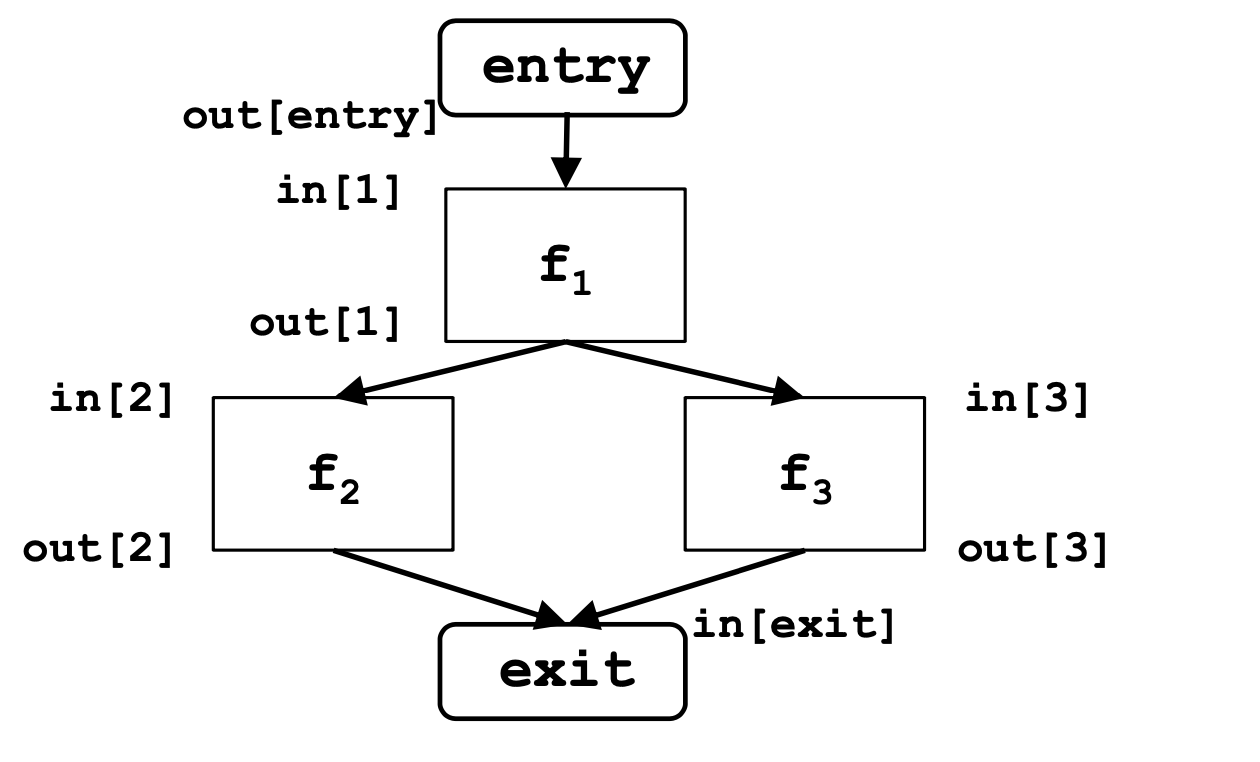
-
out[b] = $f_b$(in[b])
-
Join node: A node with multiple predecessors
-
meet operator:
- in[b] = $out[p_1] \cup out[p_2] \cup … \cup out[p_n]$ where $p_1, …, p_n$ are all predecessors of b
Reaching definitions: Iterative Algorithm
1
2
3
4
5
6
7
8
9
10
11
12
13
14
15
16
input: control flow graph CFG = (N, E, Entry, Exit)
// Boundary condition
out[Entry] = empty
// Initialization for iterative algorithm
For each basic block B other than Entry
out[B] = empty
// Iterate
While (Changes to any out[] occur) {
For each basic block B other than Entry{
in[B] = union (out[p]), for all predecessors p of B
out[B] = transfer function(in[B]) // out[B] = gen[B] union (in[B] - kill[B])
}
}
Reaching definitions: Worklist Algorithm
1
2
3
4
5
6
7
8
9
10
11
12
13
14
15
16
17
18
19
20
input: control flow grapg CFG = (N, E, Entry, Exit)
// Initialize
out[Entry] = empty
For all nodes i
out[i] = empty
ChangeNodes = N // All nodes
// Itearte
While ChangedNodes != empty:
Remove i from ChangedNodes
in[i] = union (out[p]), for all predecessors p of i
oldout = out[i]
out[i] = transfer function(in[i]) // out[i] = gen[i] union (in[i] - kill[i])
if (oldout != out[i]){
for all successors s of i
add s to ChagnedNodes
}
Example
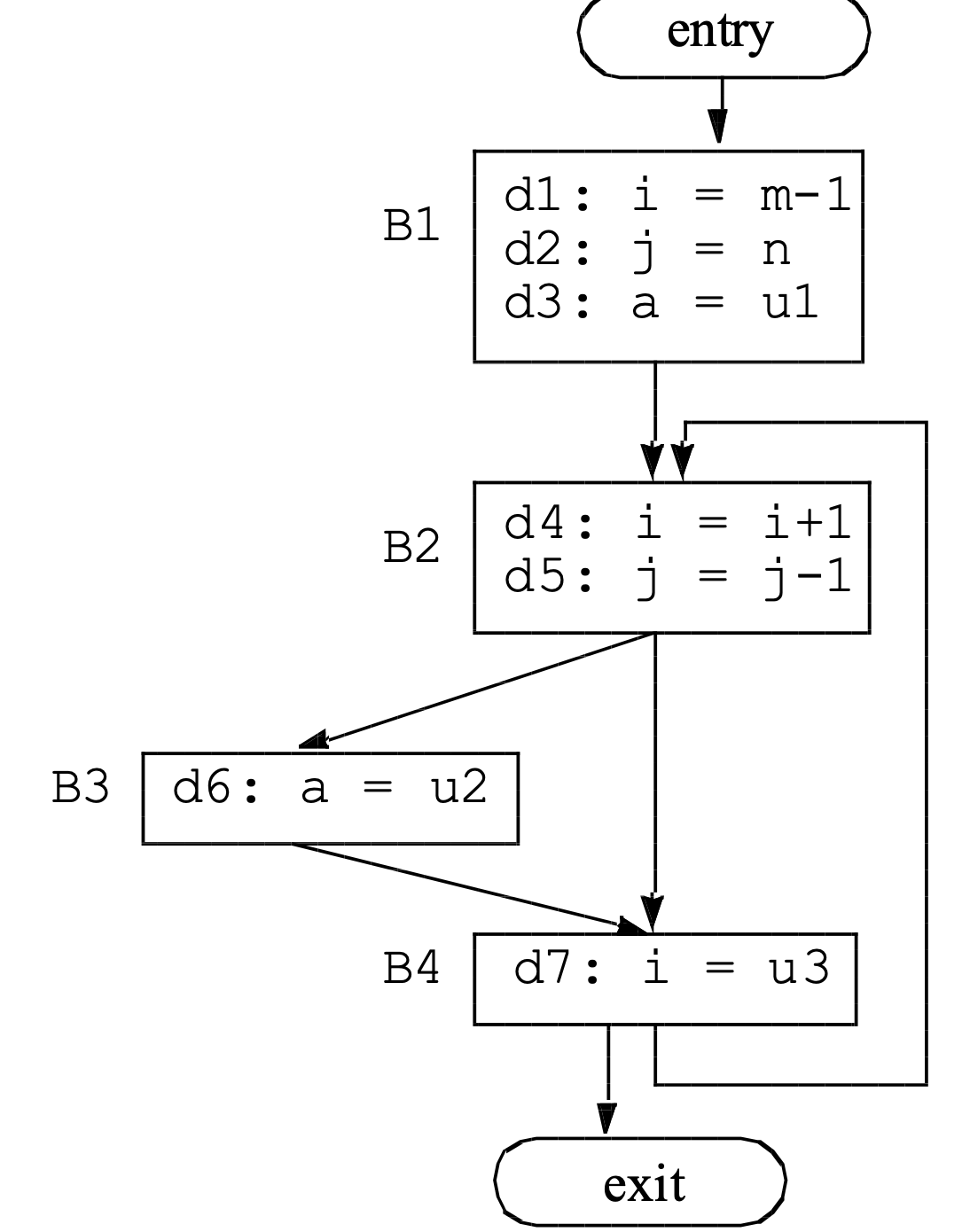
| First Iteration | Second Iteration | |
| IN[B1] | 0000000 | 0000000 |
| Gen[B1] | 1, 2, 3 | 1, 2, 3 |
| Kill[B1] | 4, 5, 6, 7 | 4, 5, 6, 7 |
| Out[B1] | 1110000 | 1110000 |
| IN[B2] | 1110000 | 1110111 |
| Gen[B2] | 4, 5 | 4, 5 |
| Kill[B2] | 1, 2, 7 | 1, 2, 7 |
| Out[B2] | 0011100 | 0011110 |
| IN[B3] | 0011100 | 0011110 |
| Gen[B3] | 6 | 6 |
| Kill[B3] | 3 | 3 |
| Out[B3] | 0001110 | 0001110 |
| IN[B4] | 0011110 | 0011110 |
| Gen[B4] | 7 | 7 |
| Kill[B4] | 1,4 | 1,4 |
| Out[B4] | 0010111 | 0010111 |
Live Variable Analysis
- Definition
- A variable v is live at point p if
- The value of v is used along some path in the flow graph starting at p
- A variable v is live at point p if
- Problem statement
- For each basic block
- Determine if each variable is live in each basic block
- Size of bit vector: one bit for each variable
- For each basic block
Transfer Function
- A basic block b can
- generate live variables: Use[b]
- set of locally exposed uses in b
- propagate incoming live variables: Out[b] - Def[b]
- where Def[b] = set of variables defined in b.b
- generate live variables: Use[b]
- Transfer function for the block b:
- in[b] = Use[b] $\cup$ (out(b) - Def[b])
Flow Graph

- in[b] = $f_b(out[b])$
- Join Node: A node with multiple successors
- meet operator:
- $out[b] = in[s_1] \cup in[s_2] \cup … \cup in[s_n]$ where $s_1, s_2, …., s_n$ are all successors of b
Liveness: Iterative Algorithm
1
2
3
4
5
6
7
8
9
10
11
12
13
input: control flow graph CFG = (N, E, Entry, Exit)
// Boundary condition
in[Exit] = Empty
// Initializeation for iterative
For each basic block B other than Exit
in[B] = Empty
// Iterate
while (Changes to any in[] occue)
out[B] = union (in[s]) // For all successor s of B
in[B] = transfer function(out[B]) // in[B] = Use[B] union (Out[B] minus Def[B])
Example

| First Iteration | Second Iteration | |
| Out[B4] | $\emptyset$ | {i, j, u2, u3} |
| Use[B4] | {u3} | {u3} |
| Def[B4] | {i} | {i} |
| In[B4] | {u3} | {j, u2, u3} |
| Out[B3] | {u3} | {j, u2, u3} |
| Use[B3] | {u2} | {u2} |
| Def[B3] | {a} | {a} |
| In[B3] | {u2, u3} | {j, u2, u3} |
| Out[B2] | {u2, u3} | {j, u2, u3} |
| Use[B2] | {i, j} | {i, j} |
| Def[B2] | {i, j} | {i, j} |
| In[B2] | {i, j, u2, u3} | {i, j, u2, u3} |
| Out[B1] | {i, j, u2, u3} | {i, j, u2, u3} |
| Use[B1] | {m, n, u1} | {m, n, u1} |
| Def[B1] | {i, j, a} | {i, j, a} |
| In[B1] | {u2, u3, m, n, u1} | {u2, u3, m, n, u1} |